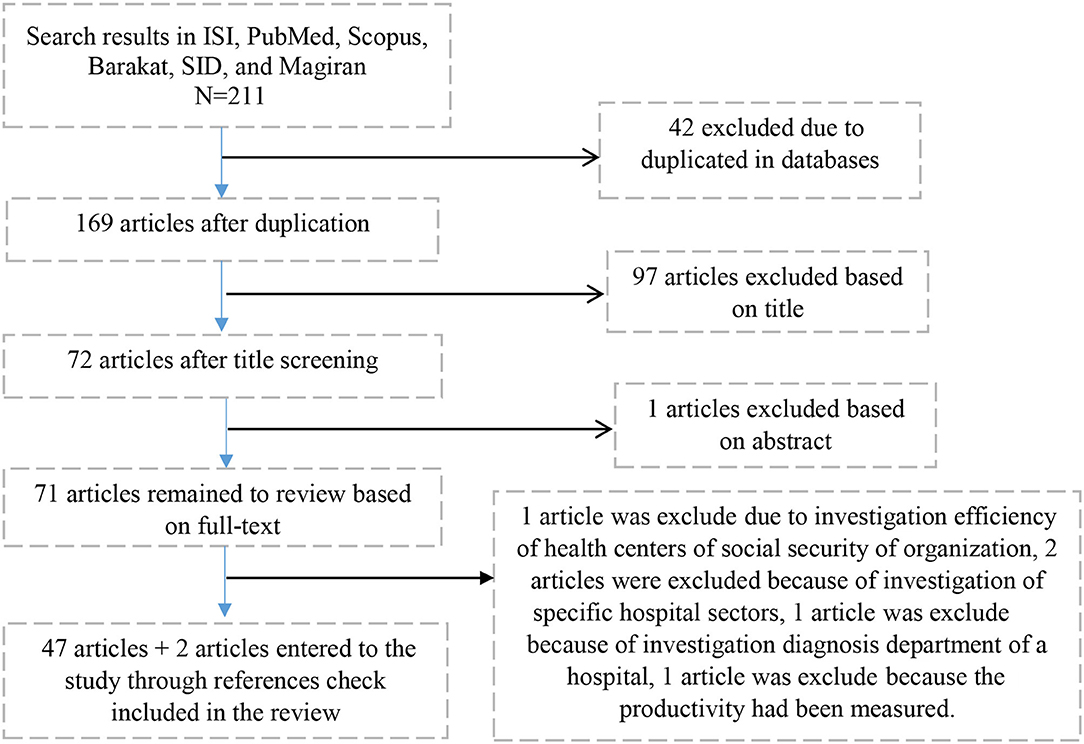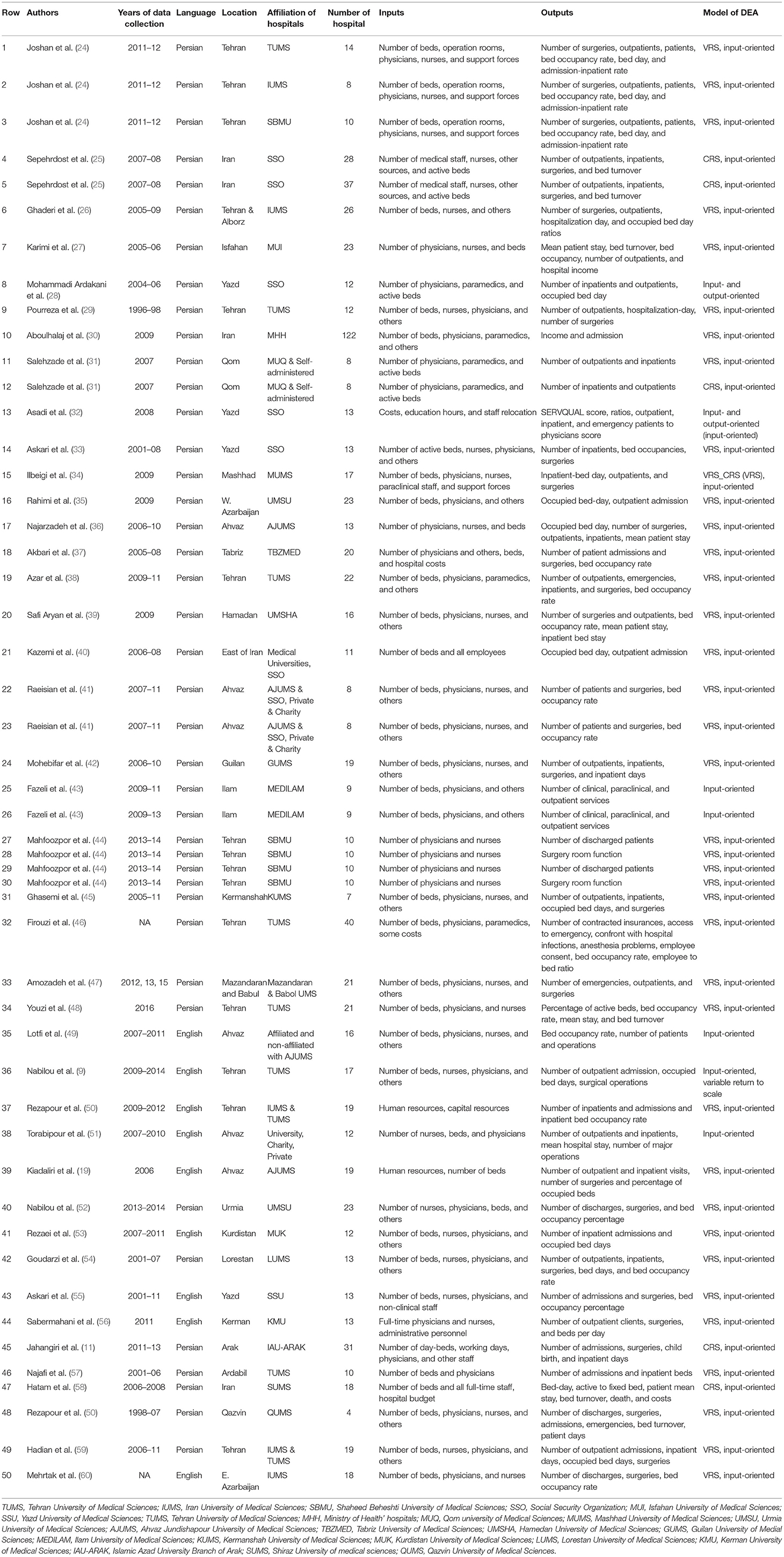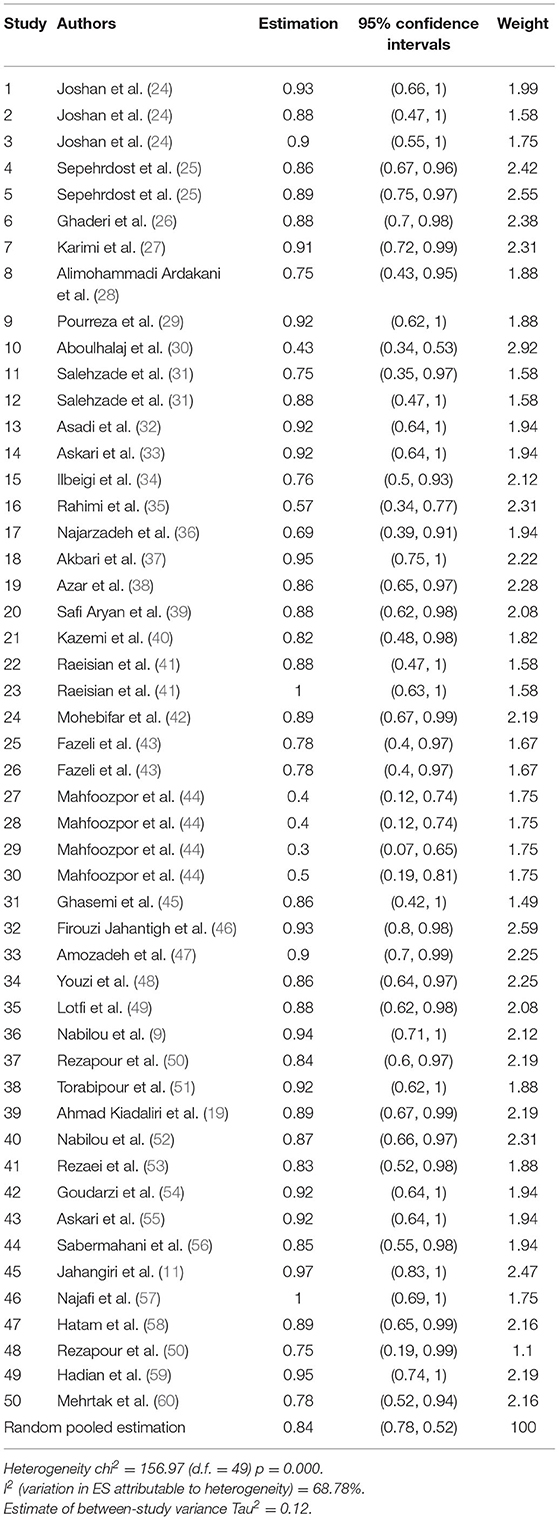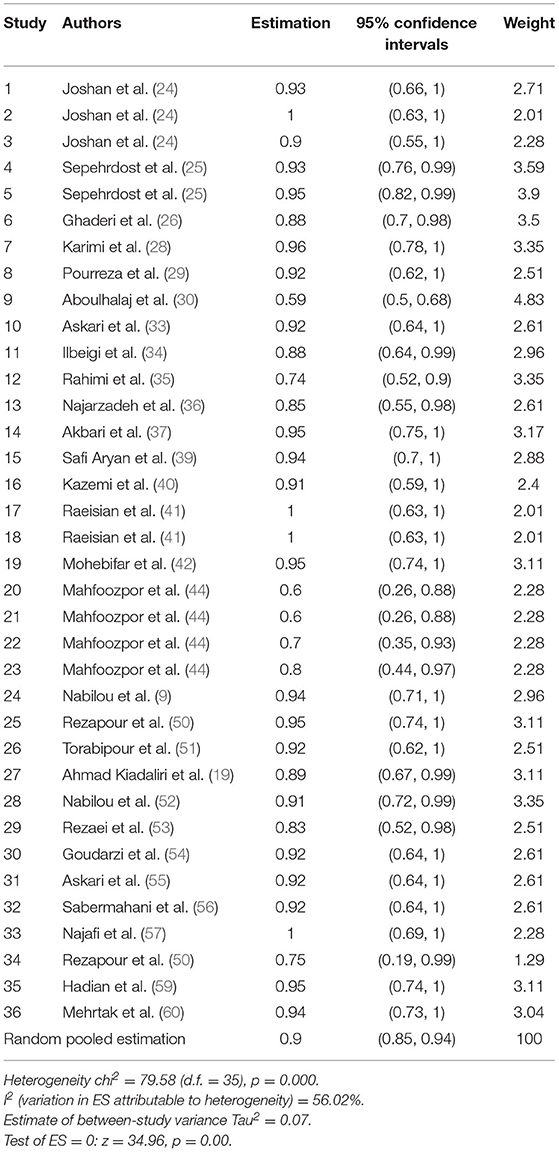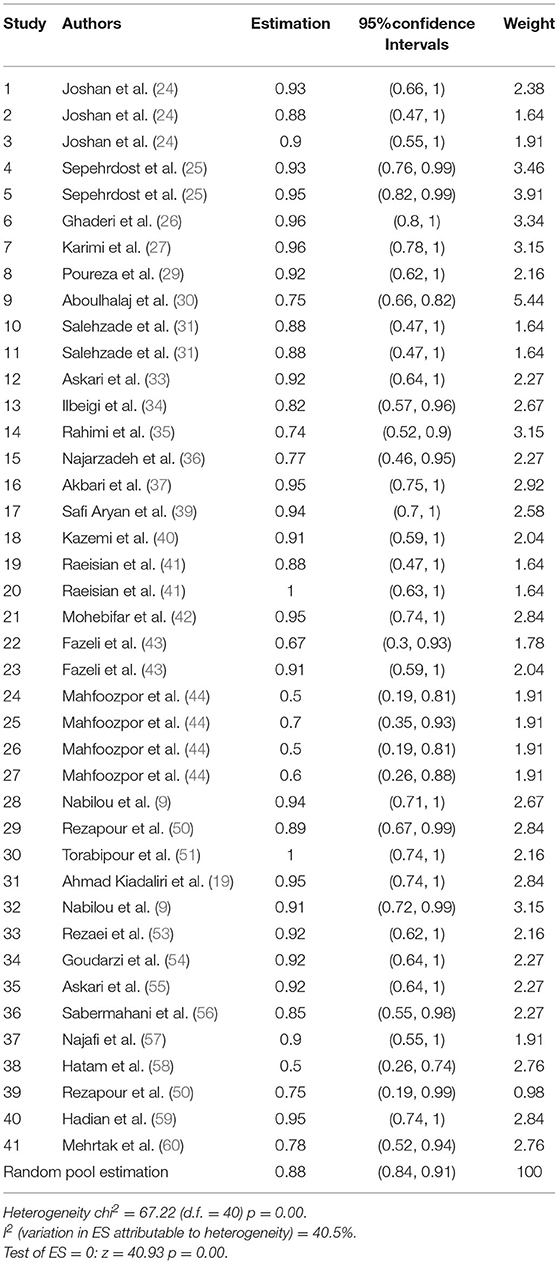- 1Department of Health Services Management, Arak University of Medical Sciences, School of Health, Arak, Iran
- 2Molecular and Medicine Research Center, Khomein University of Medical Sciences, Khomein, Iran
- 3Research Center for Environmental Determinants of Health, Health Institute, Kermanshah University of Medical Sciences, Kermanshah, Iran
- 4Department of Medical Parasitology and Mycology, School of Medicine, Arak University of Medical Sciences, Arak, Iran
- 5Department of Forensic Medicine, School of Medicine, Arak University of Medical Sciences, Arak, Iran
- 6Social Development and Health Promotion Research Center, Health Institute, Kermanshah University of Medical Sciences, Kermanshah, Iran
- 7Department of Health Management, Policy Making and Economics, Kerman University of Medical Sciences, Kerman, Iran
Purpose: Aging, chronic diseases, and development of expensive and advanced technologies has increased hospitals costs which have necessitated their efficiency in utilization of resources. This systematic review and meta-analysis study has assessed the efficiency of Iranian hospitals before and after the 2011 Health Sector Evolution Plan (HSEP).
Methods: Internal and external databases were searched using specified keywords without considering time limitations. The retrieved articles were entered into EndNote considering inclusion and exclusion criteria, and the final analysis was performed after removing duplicates. Heterogeneity between the studies was assessed using Q and I2 tests. A forest plot with 95% confidence intervals (CI) was used to calculate different types of efficiency. The data were analyzed using STATA 14.
Results: Random pooled estimation of hospitals technical, managerial, and scale efficiencies were 0.84 (95%CI = 0.78, 0.52), 0.9 (95%CI = 0.85, 0.94), and 0.88 (95%CI = 0.84, 0.91), respectively. Sub-group analysis on the basis of study year (before and after HSEP in 2011) indicated that random pool estimation of technical (0.86), managerial (0.91), and scale (0.90) efficiencies of Iranian hospitals for 2011 and before were better than technical (0.78), managerial (0.86), and scale (0.74) efficiencies after 2011.
Conclusion: Type of hospital ownership was effective on hospital efficiency. However, HSEP has not improved hospital efficiency, so it is necessary for future national plans to consider all aspects.
Introduction
Hospitals have an undeniable role in providing healthcare services to society but their increasing costs have become an important challenge for many countries. In other words, utilization of technologies and new methods of diagnosis and treatment of diseases and also increasing numbers of elderly citizens, increasing chronic diseases, increasing demands for healthcare services and specialists, and hospital errors have increased health system costs (1, 2). Because of these issues and problems, hospitals always encounter human and financial resource constraints which have necessitated efficiency in consuming resources more than ever (3).
The efficiency concept has been created from the combination of technical and allocative efficiencies. Technical efficiency means using the lowest amount of input to produce a specified amount of output or using a specified amount of input to produce more output. Allocative efficiency means using the correct amount of input in terms of prices to produce a specified amount of output. Technical efficiency, on the other hand, was created by multiplying scale efficiency and managerial efficiency. Scale efficiency is the ability of an organization unit to perform in or near the most profitable scale to prevent loss in resources. Lastly, managerial efficiency means hard working, correct policymaking, application of the correct number of employees, and the correct combination of production factors (4).
One of the most widely used methods in assessment of different decision-making units (DMUs) such as hospitals and other organizations in terms of the components of efficiency (e.g., technical, scale, and managerial efficiency) is the data envelopment analysis (DEA) method. It is possible, through this method, to create a logical framework to distribute human and financial resources between different wards and sections of studied organizations (5). The DEA method, as a non-parametric programming technique, has been used since the mid 1980s to measure DMU efficiency (6). In other words, linear and multiple programming models are used in this method to assess the relative efficiency of a field, section, unit, or an organization, as a DMU, using multiple input and output indices (7).
Numerous studies have assessed the efficiency of hospital efficiency using the DEA method. These studies can be divided into four categories. In the first category, the efficiency of university, teaching, and public hospitals, as the main providers of healthcare and therapeutic services, has been assessed in studies by Kalhor et al. (8) and Nabi lou et al. (9). In the second category, the efficiency of private hospitals has been studied and their efficiency has been compared with the first-category hospitals (10, 11). The third category includes studies on hospitals affiliated with special entities such as Social Security Organization (12, 13) and Armed Forces (14). The last category measures the efficiency of hospital wards such as radiology (15), dentistry (4), intensive care unit (16), and emergency (17) departments. Because the latter category studies wards of hospitals rather than the hospitals in their entirety and also have not assessed the technical, managerial, and scale efficiency of hospitals wholly, this category was excluded from the current study.
Although many studies have assessed the efficiency of hospitals using the DEA method in Iran, there has been no systematic review and meta-analysis study in this regard to present the final situation of hospital efficiency in Iran. By determining technical, managerial, and scale efficiency of Iranian hospitals, policymakers and planners can improve hospital efficiency through improving distribution and consumption of resources.
The extensive review of the literature by the authors of the current study has resulted in four systematic review and meta-analysis studies on Iranian hospital efficiency using the DEA method. The first study assessed studies in terms of the provinces where they were performed, whether they were input- or output-oriented, and whether they were fixed or variable return to scale models (18). The researchers in another two systematic and meta-analysis studies discussed the methods used to assess hospital efficiency (19, 20). The last study only included a small number of studies on hospital efficiency and did not mention the efficiency subdimensions namely scale, managerial, and technical efficiency (21). As previous systematic review and meta-analysis studies have not assessed hospital efficiency using its subcategories, the current study assessed technical, managerial, and scale efficiency of hospitals through systematic review and meta-analysis.
Regarding PICOS framework or questions, the study included hospitals in Iran which had previously had their efficiency assessed and were entered into the study depending on the inclusion and exclusion criteria. The intervention framework was the assessment of the effect of HSEP on hospital efficiency, comparisons included comparing hospital efficiency before and after HSEP, outcomes included the amount of hospital efficiency, and finally the study design included assessment of hospital efficiency through systematic review and meta-analysis.
Materials and Methods
Search Strategy
The international databases of the Institute for Scientific Information (ISI), PubMed, Scopus, Google Scholar, and Persian databases of Scientific Information Database (SID), Magiran, and Barakat were searched using the combination of “efficiency,” “hospital,” “data envelopment analysis,” “DEA,” and “Iran” keywords in 2018. The references of the retrieved articles were searched to increase the study credibility and precision.
Inclusion and Exclusion Criteria
All published Persian and English language articles about hospital efficiency with a score between 8 and 12 were entered into the study without considering a time limit. If several formats of a research were published (such as a book, article, report, and so on), only one of them was entered into the study. Input-oriented studies were entered into the study. Short reports, letters to editors or editorial comments, one study that was available in two languages, studies on health care facilities other than hospitals, and studies on internal parts of hospitals were removed from the study. Two researchers assessed and extracted data from the studies independently and a third researcher resolved disagreements if they appeared.
This systematic review and meta-analysis utilized Preferred Reporting Items for Systematic Reviews and Meta-Analyses (PRISMA) guidelines to minimize potential sources of bias (22).
Data Collection
A researcher-made checklist in an Excel spreadsheet was created to extract the studies' data including the first author name, year of data collection, place of study, language, sample size, and the score of technical, managerial, and scale efficiency. Another checklist designed previously, whose credibility has been proved by numerous studies, was used to assesses the studies' quality (19, 21). This checklist includes 12 questions regarding the study aim, method, data collection, sample size, and study population. Each question has the score between 0 and 1 and the score for each study is calculated by summing the scores of questions. So that the studies with scores between 8 and 12 were entered into the final analysis. The study protocol was approved by the Ethical Committee of Kerman University of Medical Sciences.
Data Analysis
Efficiency types were considered as a proportion in this study. Therefore, the numerator was the sum of technical, managerial, and efficiency scores and the denominator was the number of study hospitals. Heterogeneity between the studies was assessed using Q and I2 tests. A P-value lower than 0.05 for the Q-test and an I2 higher than 50% were considered as the measures of studies' heterogeneity. Because the studies were heterogeneous, the random effect model was used to estimate hospital efficiency. A forest plot with 95% confidence intervals (CI) was used to calculate different types of efficiency. Egger's and Begg's tests were used to assess publication bias. In order to assess the effect of the 2011 Iran Health Sector Evolution Plan (HSEP) (23) on hospital efficiency, the studies before and after it were compared. The data were entered into Excel 2016 to be edited and then transmitted and analyzed using STATA v.14.2.
Results
Each one of the scientific databases were searched on the basis of a recommended search strategy by the databases themselves using defined keywords. For example, in the PubMed database, 23 articles were retrieved after placing the search query. Search query used for PubMed was: (((data envelopment analysis) OR DEA) AND hospital) AND Iran))). Among retrieved articles, nine articles had assessed efficiency in other areas such as radiology units, intensive care units, and health centers which were excluded from the study. So, finally 14 articles from the PubMed database were entered into the EndNote software. In other databases, after adjusting the search query on the basis of the database guide and then removing unrelated retrieved articles through reading titles, abstracts, and texts, 25 articles from Scopus, 41 from Google Scholar, 8 from Web of Science, 16 from Barakat, 14 from Magiran, and 7 from SID were entered into the EndNote software. After combination of these articles in the EndNote software and removing duplicate articles, 47 final articles remained. Also, the assessment of references of these articles resulted in two new articles. In this way, 49 articles were entered into the final step of the systematic review and meta-analysis. Twelve articles (24.48%) of these were in the Persian language and the remaining were in the English language. A PRISMA flow chart of the study retrieval and selection process with reasons for exclusion at each stage is provided in Figure 1.
By attention that some studies have reported efficiency in several forms or in different scenarios and different inputs were used in them, we considered them as separated studies. In this regard, studies of Hatam et al., Karimi et al., Salehzade et al., Raeisian et al., Firouzi Jahantigh et al., and Sheikhzadeh et al. were each considered as two separated studies. Studies of Joshan et al. and Asadi et al. were each considered as three studies and lastly studies of Fazeli et al. and Mahfoozpor et al. were each considered as four studies. The average number of hospitals entered into the studies was 17.59 hospitals. The lowest and the highest number of hospitals belonged to Rezapour et al. with 4 hospitals and Aboulhalaj et al. with 122 hospitals, respectively.
As mentioned before, each type of efficiency was entered into the meta-analysis separately, so that 50 studies for technical efficiency, 36 studies for managerial efficiency, and 41 studies for scale efficiency had entry requirements to the analysis.
The studies were performed from 1996 to 2016. After performing all the steps of study selection, 49 articles were entered into the final phase of the study. The number of hospitals assessed in these articles ranged from 4 to 122. The inputs considered in the studies included number of beds, number of operation rooms, physicians, nurses, support forces and other human resources, costs, education hours, and working days. The outputs were number of surgeries, outpatients, occupancy rate, bed days, admission, inpatients, surgeries, emergencies, bed turnover, mean patient stay, hospital income, bed occupancy rate, SERVQUAL score, number of clinical, paraclinical, and outpatient services, number of discharged patients, number of contracted insurance companies, access to emergency room, confronted with hospital infections, anesthesia problems, employee consent, active to fixed bed ratio, number of deaths, and patient-day. Two studies assessed charity hospitals, four studies assessed private hospitals, and five studies assessed Social Security Organization (SSO) hospitals. The remaining studies assessed hospitals affiliated with universities of medical sciences belonging to the Iran Ministry of Health (Table 1).
The results indicated that there was heterogeneity in studies related to technical efficiency (heterogeneity chi2 = 156, p < 0.001), managerial efficiency (heterogeneity chi2 = 79.58, p < 0.001), and scale efficiency (heterogeneity chi2 = 67.22, p < 0.001). I2 index in technical and managerial efficiency was higher than 50%, which indicates high heterogeneity between the studies. This index was lower than 50% for scale efficiency.
Study publication error using Egger's test indicated that there was publication bias in technical and managerial efficiencies (P < 0.001), but there was no publication bias in scale efficiency (p = 0.19). Table 2 displays the results of Egger's testing for the three types of efficiencies. Begg's test indicated that there was no publication bias in the three types of efficiencies (P < 0.001).
The results indicated that technical efficiency of Iranian hospitals had high variation, so that it ranged from 0.34 in the Mahfoozpor et al. study to 1 in Raeisian et al. and Najafi et al. On the basis of random effects modeling, random pooled estimation of hospital technical efficiency was 0.84 (95% CI = 0.52, 0.78) (Table 3, Figure 2). The managerial efficiency of Iranian hospitals was between 0.59 in the Aboulhalaj et al. study and 1 in studies of Joshan et al., Raeisian et al., and Najafi et al. Random pooled estimation of managerial efficiency of Iranian hospitals was 0.90 (95% CI = 0.85,0.94) (Table 4, Figure 3). The lowest amount of scale efficiency (0.52) was in the Mahfoozpor et al. study and the highest (1) was in the Raeisian et al. and Torabipour et al. studies. Random pool estimation of scale efficiency for Iranian hospitals was 0.88 (95%CI = 0.84, 0.91) (Table 5, Figure 4). The results of technical, managerial, and scale efficiencies are presented in Tables 2, 4, 5, respectively. In addition, the forest plots for technical, managerial, and scale efficiencies are presented in Figures 1–3, respectively.
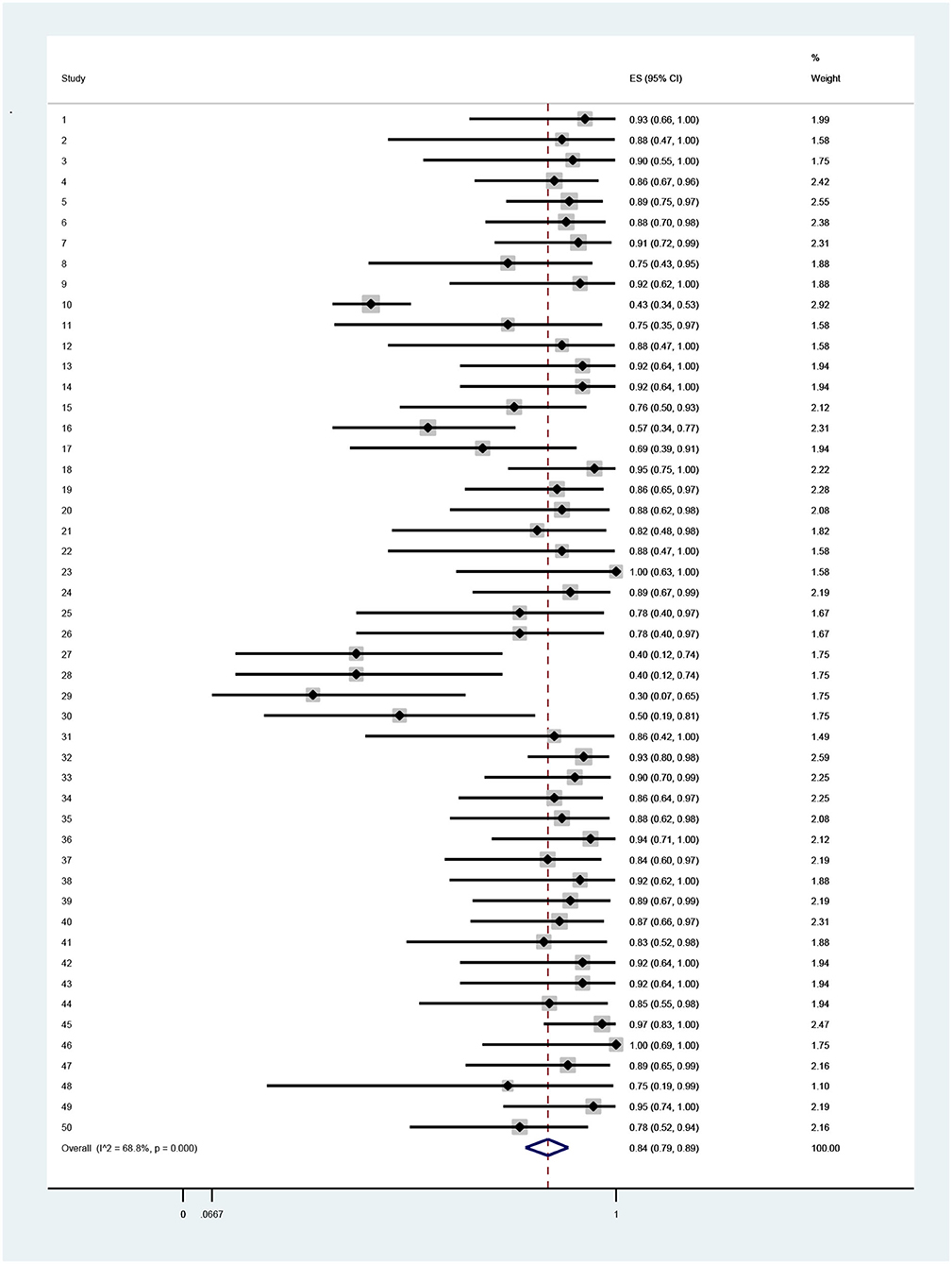
Figure 2. Forest plot of estimates and 95% confidence intervals of the technical efficiency among Iranian hospitals.
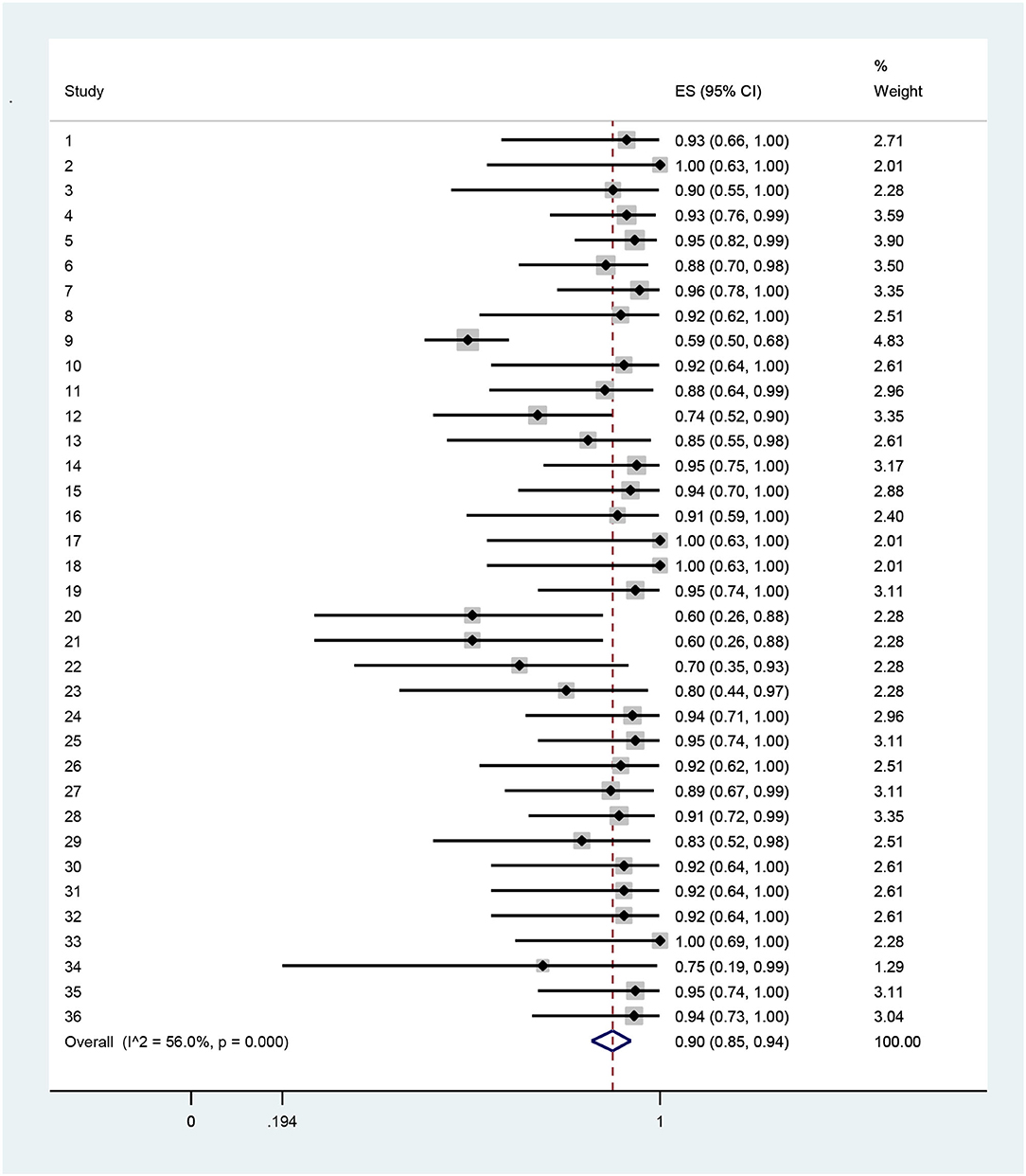
Figure 3. Forest plot of estimates and 95% confidence intervals of the managerial efficiency among Iranian hospitals.
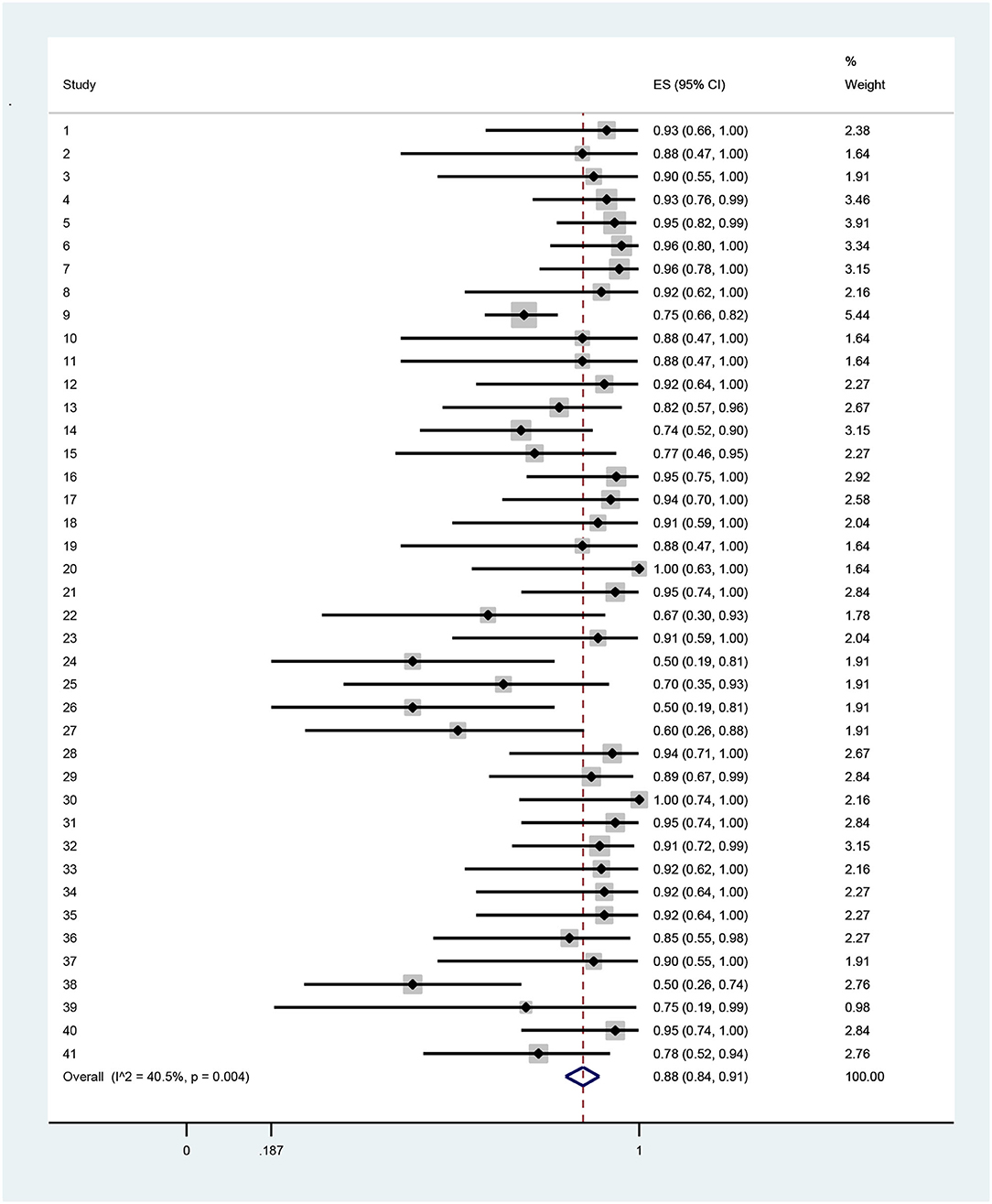
Figure 4. Forest plot of estimates and 95% confidence intervals of the economics of scale efficiency among Iranian hospitals.
Sub-group analysis based on study year indicated that random pool estimation of technical efficiency of Iranian hospitals for 2011 and before and after 2011 was 0.86 (95% CI = 0.80, 0.91) and 0.78 (95%CI = 0.64, 0.89), respectively. The status of managerial efficiency for 2011 and before was better than after 2011 (random pool estimation equal to 0.91, compared to 0.86). Random pool estimation of scale efficiency for 2011 and before was 0.90 (95%CI = 0.86, 0.93), while random pool estimation of scale efficiency for after 2011 was 0.74 which is lower (95%CI = 0.61, 0.86) (Table 6).

Table 6. The random pool estimation of technical, managerial, and economics of scale efficiencies among Iranian hospitals by time of studies.
Discussion
The assessment of hospital efficiency provides the groundwork to assess their performance and increase productivity when using limited resources. One of the ways of assessing allocated resources to obtain specified goals is efficiency studies. In summary, efficiency means using resources to their maximum to produce goods and services (61).
This is the first systematic review and meta-analysis study regarding assessment of the efficiency of Iranian hospitals in terms of its subcategories namely technical, managerial, and scale efficiencies. Different methods have been used to assess Iranian hospital efficiency such as DEA, Pabon-Lasso, and Stochastic Frontier Analysis (SFA) in past decades (21). In this regard, as this study indicates, the DEA method is the most widely applied method to assess hospital efficiency (19).
Our findings showed that the random pool estimations of technical, managerial, and economics of scale efficiency were 0.87, 0.9, and 0.88, respectively. This finding indicates that the resources of the studied hospitals in Iran have been used in an inefficient way. One idea about hospital efficiency is that the expectation from hospitals to work efficiently is far from reality. The reasoning for this claim is the economic theory of firms that declare the hospitals cannot work at full efficiency because of uncertainty in costs and prices of services that they provide. In summary, lack of information on costs and prices is one of the main factors that has a negative effect on hospital efficiency (6, 62).
Most of the studies were implemented in Tehran province (13 studies). Four studies investigated the efficiency of hospitals across all provinces of Iran. However, some provinces such as Sistan and Baluchistan had no individual reports about the efficiency of their hospitals. Therefore, there is an information gap for health policymakers and hospital managers in this field.
As the results indicated, most of the researchers tended to perform analyzes through the input-oriented method, because inputs are in the control of hospital managers, so that by creating changes in the inputs can change the rate of outputs to the desired extent. However, it is suggested that private and for-profit hospitals are excluded from this rule, because the managers of these type of hospitals want to maximize outputs and, as a result, hospital profits (63).
Human and capital resources such as the number of nurses and physicians and the number of beds were the main inputs in all included studies. Number of surgeries, outpatient admissions, inpatient admissions, bed days, and bed occupancy rate were the most frequent outputs considered in the studies to estimate the efficiency of hospitals. Today, the management of all resources, especially human resources in the health care industry is recognized as a vital issue for all healthcare organizations (64). Furthermore, better management of human resources is associated with higher patient outcomes without significant increases in the cost of hospitals (65).
The results indicated that most hospital efficiency studies suffer from some weak points. Therefore, the selection of inputs has been performed on the basis of resource review (e.g., previous published articles) not consideration of each hospital situation. Also, the inputs were not weighted, so that the resources with high specialty and expenditure receive the same weight as others. Hospital case mix has not been considered in this hospital efficiency assessment. This leads to low efficiency assessment in hospitals which have the most complicated cases. Lastly, some studies have not considered the data validity and the appropriate ratio of inputs and outputs with the number of hospitals precisely.
The study of Contor VJM and Poh Kl also provides some theoretical and methodological limitations of the DEA method in capturing the full view of efficiency of healthcare centers (66). However, with a suitable study design, the DEA method is among the most important and most applicable methods in the assessment of health system efficiency, especially hospitals (67).
The results indicated that technical, managerial, and scale efficiency of Iranian hospitals after performing HSEP decreased in comparison with before it. A study on Turkey hospitals from 2001 to 2006, which measured the effect of Turkey health sector reform on hospital efficiency to provide policy implications for policymakers, indicated that this reform had increased the efficiency of public hospitals but the efficiency of private hospitals had decreased (68).
As there was no hospital with full efficiency in the study and the increasing trend of health system costs and scarce resources, it is proposed to design and implement a system to monitor efficiency and consumption of resources especially in hospitals. This can help to identify inefficient hospitals and the causes of it. Health policymakers through cost management planning and increasing outputs can pave the way in this regard.
Strengths and Limitations
This is the first comprehensive systematic review and meta-analysis evaluating efficiency of Iranian hospitals which is applicable for comparison of the efficiency of hospitals before and after HSEP. The methodology adhered to the PRISMA statement (22).
The strength of the study is in performing meta-analysis after the systematic review which has specified the exact amount of technical, managerial, and scale efficiencies of Iranian hospitals. The Cochrane Consumers and Communication Review Group's data extraction template (69) was used to obtain the needed information about the studies included. Nevertheless, the retrieved studies were mainly administered in some easily accessible areas rather than in a balanced distribution all over the country. This limits the generalizability of the results.
Conclusion
This study indicated that many hospitals are inefficient. This implies that there is considerable room for efficiency improvement in hospitals. Hospital management has a unique role in this regard. Health systems have reformed in spite of increasing access and utilization of patients to the services, but have not considered efficiency improvement in hospitals. So, health policymakers and hospital managers should design and implement some related programs in order to monitor and improve the efficiency of hospitals.
Data Availability Statement
The original contributions presented in the study are included in the article/supplementary material, further inquiries can be directed to the corresponding author/s.
Ethics Statement
This systematic review and meta-analysis study was approved by the Ethical Committee of Arak University of Medical Sciences (Ethical Code Number: IR.ARAKMU.REC.1398.044).
Author Contributions
SA, BK, AK-K, and MD: conception and design of study/review/case series. SA, MA, YS, and AA: acquisition of data. YS, AA, MD, BK, and MA: analysis of collected data. SA, AK-K, YS, MD, AA, and YS: interpretation of data and drafting of paper and/or critical revision. All the authors have read and approved the manuscript to be submitted to BMC Health Services Research.
Funding
This paper is retrieved from an approved research project. The Deputy of Research of Arak University of Medical Sciences has financially supported this study in different parts of the study including design, data collection, analysis, interpretation, and writing the manuscript (Grant Number: 3382).
Conflict of Interest
The authors declare that the research was conducted in the absence of any commercial or financial relationships that could be construed as a potential conflict of interest.
Publisher's Note
All claims expressed in this article are solely those of the authors and do not necessarily represent those of their affiliated organizations, or those of the publisher, the editors and the reviewers. Any product that may be evaluated in this article, or claim that may be made by its manufacturer, is not guaranteed or endorsed by the publisher.
Acknowledgments
The authors would like to acknowledge the Deputy of Research of Arak University of Medical Sciences for financial support of this study and providing the background to perform this study.
Abbreviations
HSEP, Health Sector Evolution Plan; CI, confidence interval; DEA, data envelopment analysis; DMUs, decision making units; SSO, Social Security Organization; ISI, Institute for Scientific Information; SID, Scientific Information Database; PRISMA, Preferred Reporting Items for Systematic Reviews and Meta-Analyses.
References
1. Rezaei S, Fallah R, Kazemi Karyani A, Daroudi R, Zandiyan H, Hajizadeh M. Determinants of healthcare expenditures in Iran: evidence from a time series analysis. Med J Islam Repub Iran. (2016) 30:313.
2. Johnson G, Frakt A. Hospital markets in the United States, 2007–2017. Healthcare. (2020) 8:100445. doi: 10.1016/j.hjdsi.2020.100445
3. Li Y, Lei X, Morton A. Performance evaluation of nonhomogeneous hospitals: the case of Hong Kong Hospitals. Health Care Manag Sci. (2018) 18:1–14. doi: 10.1007/s10729-018-9433-y
4. Barouni M, Amiresmaieli MR, Shahravan A, Amini S. The efficiency assessment of dental units using data envelopment analysis approach: the case of Iran. Iran J Public Health. (2017) 46:552.
5. Kontodimopoulos N, Nanos P, Niakas D. Balancing efficiency of health services and equity of access in remote areas in Greece. Health Policy. (2006) 76:49–57. doi: 10.1016/j.healthpol.2005.04.006
6. Hollingsworth B, Dawson P, Maniadakis N. Efficiency measurement of health care: a review of non-parametric methods and applications. Health Care Manag Sci. (1999) 2:161–72. doi: 10.1023/A:1019087828488
7. Banker RD, Charnes A, Cooper WW. some models for estimating technical and scale inefficiencies in data envelopment analysis. Manag Sci. (1984) 30:1078–92. doi: 10.1287/mnsc.30.9.1078
8. Kalhor R, Amini S, Sokhanvar M, Lotfi F, Sharifi M, Kakemam E. Factors affecting the technical efficiency of general hospitals in iran: data envelopment analysis. J Egypt Public Health Assoc. (2016) 91:20–5. doi: 10.1097/01.EPX.0000480717.13696.3c
9. Nabilou B, Yusefzadeh H, Rezapour A, Azar FEF, Safi PS, Asiabar AS, et al. The productivity and its barriers in public hospitals: case study of Iran. Med J Islam Rep Iran. (2016) 30:316.
10. Sheikhzadeh Y, Roudsari AV, Vahidi RG, Emrouznejad A, Dastgiri S. Public and private hospital services reform using data envelopment analysis to measure technical, scale, allocative, and cost efficiencies. Health Promot Perspect. (2012) 2:28. doi: 10.5681/hpp.2012.004
11. Jandaghi G, Matin HZ, Doremami M, Aghaziyarati M. Efficiency evaluation of qom public and private hospitals using data envelopment analysis. Eur J Econ Finance Adm Sci. (2010) 22:83–91.
12. Hajialiafzali H, Moss J, Mahmood M. Efficiency measurement for hospitals owned by the iranian social security organisation. J Med Syst. (2007) 31:166–72. doi: 10.1007/s10916-007-9051-6
13. Hatam N, Pourmohammadi K, Keshtkaran A, Javanbakht M, Askarian M. Factors affecting efficiency of social security hospitals in iran: data envelopment analysis. HealthMED. (2012) 6:1961–8.
14. Abolghasemi K, Teymourzadeh E. Performance evaluation and ranking of selective wards in a military hospital using DEA and promethee Method. J Mil Med. (2017) 18:325–34.
15. Keshtkaran A, Barouni M, Ravangard R, Yandrani M. Economic efficiency of radiology wards using data envelopment analysis: case study of Iran. Health. (2014) 6:311. doi: 10.4236/health.2014.65045
16. Bahrami MA, Rafiei S, Abedi M, Askari R. Data envelopment analysis for estimating efficiency of intensive care units: a case study in Iran. Int J Health Care Qual Assur. (2018) 31:276–82. doi: 10.1108/IJHCQA-12-2016-0181
17. Gharahighehi A, Kheirkhah AS, Bagheri A, Rashidi E. Improving performances of the emergency department using discrete event simulation, DEA and the MADM methods. Digit Health. (2016) 2:2055207616664619. doi: 10.1177/2055207616664619
18. Jahangiri A. Application of data envelopment analysis technique in iranian hospitals (a systematic review). J Hosp. (2016) 15:103–24. doi: 10.22105/DMOR.2019.82229
19. Kiadaliri AA, Jafari M, Gerdtham U-G. Frontier-based techniques in measuring hospital efficiency in Iran: A systematic review and meta-regression analysis. BMC Health Serv Res. (2013) 13:312. doi: 10.1186/1472-6963-13-312
20. Bahadori M, Izadi AR, Ghardashi F, Ravangard R, Hosseini SM. The evaluation of hospital performance in Iran: a systematic review article. Iran J Public Health. (2016) 45:855. doi: 10.5812/traumamon.31382
21. Mosadeghrad AM, Esfahani P, Nikafshar M. Hospitals' Efficiency in Iran: a systematic review and meta-analysis of two decades of research. J Payavard Salamat. (2017) 11:318–31. doi: 10.4103/jehp.jehp_393_18
22. Moher D, Liberati A, Tetzlaff J, Altman DG, Group P. Preferred reporting items for systematic reviews and meta-analyses: the PRISMA statement. PLoS Med. (2010) 6:E1000097. doi: 10.1016/j.ijsu.2010.02.007
23. Moradi-Lakeh M, Vosoogh-Moghaddam A. Health sector evolution plan in iran; equity and sustainability concerns. Int J Health Policy Manag. (2015) 4:637–40. doi: 10.15171/ijhpm.2015.160
24. Joshan S, Shah Hoseini R, Fetros MH. Technical Efficiency analyses in hospitals of tabriz university of medical sciences. Teb and Tazkieh. (2016) 1:37–48.
25. Sepehrdoust H, Rajabi E. Factors Effective on Technical Efficiency and Ranking of Efficient Units in Social Security Hospitals. Health Info Manag. (2012) 9:887–94.
26. Ghaderi H, Goudarzi G, Gohari M. Determination technical efficiency of hospitals affiliated with Iran University of Medical Science by Data Envelopment Analysis (2000–2004). Jha. (2007) 9:39–44. Available online at: http://jha.iums.ac.ir/article-1-42-fa.html
27. Karimi S, Sajadi H, Karami M, Torkzad L, Bidram R. efficiency estimation in general hospitals of isfahan university of medical sciences during 2005-2006 by data envelopment analysis. J Health Adm. (2009) 12:39–46.
28. Mohammadi Ardakani A, Mirghafouri SH, Mirfakhreddini SH, Damki AM, Momeni H. Assessment of Relative Efficiency of Governmental Hospitals of Yazd Province Using DEA. J Yazd Univ Med Sci. (2009) 17:200–8.
29. Pourreza A, Goudarzi G, Azadi H. Determination of technical efficiency of hospitals affiliated with tehran university of medical science by the data envelopment analysis method: 1996–2006. J School Public Health Ins Public Health Res. (2010) 7:4.
30. Abolhalaj M, Ahmad Kiadaliri AA, Najafi B. Measuring technical efficiency of hospitals affiliated with universities of medical sciences. Teb va Tazkiye. (2010) 19:49–61.
31. Salehzadeh R, Ketabi S. Measuring the Efficiency of Qom Hospitals With Data Envelopment Analysis and Analytic Hierarchy Process. Health Info Manag. (2011) 8:479–89.
32. Sadeghi Arani Z, Asadi M, Mirghafouri SH, Khosravanian H. Qualitative performance evaluation of hospitals using DEA, balanced scorecard and servqual; a case study of general hospitals of Yazd. J Shaheed Sadoughi Univ Medical Sci. (2011) 18:559–69.
33. Askari R, Goudarzi R, Fallahzadeh H, Zarei B, Dehqani Tafti A. Efficiency appraisal of yazd university of medical science hospitals by quantitative approach data envelopment Analysis(DEA). Payavard Salamat. (2012) 6:215–24.
34. Ilbeigi A, Kazemi M, Peivandi MT. Relationship Between Official Performance Measurement Scores and Relative Efficiency in General Hospitals. Hosp. (2012) 11:31–44.
35. Rahimi B, Yusefzade H, Khalesi N, Valinejadi A, Gozali A, Akbari S, et al. Analysis of the efficiency and optimal consumption of resources in selected hospitals in urmia province through data envelopment analysis. J Health Adm. (2012) 15:91–102.
36. Najjar Zadeh M, Ghasem Zadeh R, Salehi R, Torabi Pour A. Assessment of hospitals efficiency by data envelopment Analysis in Ahvaz in 2006-2010. Jundishapur J Health Sci. (2012) 4:77–87.
37. Arab M, Akbari F, Dadashi A, Keshavarz K. Technical efficiency analyses in hospitals of Tabriz University of medical sciences. J Hosp. (2012) 11:2011.
38. Azar A, Valipour Khatir M, Moghbel Baerz A, Hasas Yeganeh Y. evaluation of hospital efficiency by data envelopment analysis: Tehran University of medical sciences: 2009-2011. J Health Adm. (2013) 16:36–46.
39. Safi Arian R, Shahhoseini R. Assessment of technical efficiency of hospitals under hamadan university of medical sciences on performance indicators and data envelopment analysis model in 2010. Pajouhan Sci J. (2013) 11:27–34.
40. Kazemi Z, Ahmad Kiadaliri AA. Haghparast h. Estimating efficiency and optimal resource utilization in selected hospitals in East of Iran: applying the data envelopment analysis. J Iran Inst Health Sci. (2013) 12:449–58.
41. Raeesian S, Eslamian M, Lotfi F, Yousefzadeh H, Moradi N, Kalhor R. Comparison of productivity between university and non-university hospitals in Ahvaz: Using MALEMQUIST‘S index and DEA. Jundishapur Sci Med J. (2014) 13:689–98.
42. Mohebbi far R, Goudarzi G, Rahimi H. Technical efficiency in hospitals of guilan university of medical sciences. Guilan Univ Med Sci. (2014) 22:73–9.
43. Fazeli E, Vafaei F, Jamshidi Navid B. Investigation on efficacy of the hospitals affiliated to Ilam university of medical sciences by DEA method. J Ilam Univ Med Sci. (2015) 23:89–97.
44. Mahfoozpour S, Pouragh B, Abedi Z, Satarivand S. Assessing efficiency in hospitals of Shahid Beheshti university of medical sciences using data envelopment analysis method. J Health Promotion Management. (2015) 5:11–20.
45. Goudarzi G, Soufi M, Rajabi Guilan N, Ghasemi SR. Measuring the technical efficiency of kermanshah university of medical sciences hospitals, using data envelopment analysis method (DEA): 2005-2011 (Nonparametric Approach). J Rafsanjan Univ Med Sci. (2015) 13:739–48.
46. Firouzi Jahantigh F, Ostovare M. Performance Evaluation of hospitals affiliated to tehran university of medical sciences using a hybrid model of data envelopment analysis and PROMETHEE Method. Iran Occup Health Journal. (2017) 14:140–52.
47. Amoozadeh Doghikola A, Shahverdi R, Rezaei Balf F. Comparison of relative efficiency of hospitals affiliated to babol and mazandaran universities of medical sciences before and after health development plan with data envelopment analysis method. J Babol Univ Med Sci. (2018) 20:68–4.
48. Yozi H, Maleki S, Mohammadian F. The Effect of Various management styles on hospital's efficiency of Tehran University of medical science in 2016. Zanko Med J Kurd Univ Med Sci. (2018) 4:1–15.
49. Lotfi F, Kalhor R, Bastani P, Shaarbafchi Zadeh N, Eslamian M, Dehghani MR, et al. Various Indicators for the assessment of hospitals' performance status: differences and similarities. Iran Red Crescent Med J. (2014) 16:E12950. doi: 10.5812/ircmj.12950
50. Rezapour A, Ebadifard Azar F, Yousef Zadeh N, Roumiani Y, Bagheri Faradonbeh S. Technical efficiency and resources allocation in university hospitals in Tehran, 2009-2012. Med J Islam Repub Iran. (2015) 29:266.
51. Torabipour A, Najarzadeh M, Arab M, Farzianpour F, Ghasemzadeh R. Hospitals productivity measurement using data envelopment analysis technique. Iran J Public Health. (2014) 43:1576–81.
52. Nabilou B, Yusefzadeh H, Salem Safi P. Performance assessment of health system reform plan in the hospitals affiliated with urmia university of medical sciences. J Urmia Nurs Midwifery Fac. (2017) 14:896–905.
53. Rezaei S, Dopeykar N, Barouni M, Jafari M, Gharibi F. Do hospitals affiliated with the kurdistan university of medical sciences perform efficiently? non-parametric data envelopment analysis. Hosp Pract Res. (2016) 1:135–40. doi: 10.21859/hpr-0104135
54. Goudarzi G, Imani NMH, Jahanmehr N, Rostami K, Omidfar R, Mahooti F. Hospital performance assessment of lorestan university of medical sciences. Health Monitor. (2012) 11:3309–315.
55. Askari R, Farzianpour F, Goudarzi R, Shafii M, Sojaei S. Efficiency evaluation of hospitals affiliated with yazd university of medical sciences using quantitative approach of data envelopment analysis in the year 2001 to 2011. Pensee J. (2014) 76:416–25.
56. Sabermahani A, Goudarzi G, Barouni M, Khakian M. Estimation of technical efficiency of general hospitals of kerman university of medical sciences by data envelopment analysis (dea) method in 2007. J Kerman Univ Med Sci. (2010) 17:59–67.
57. Najafi B, Beheshti Dehkordi A, Emami Meibodi A. The productivity of general hospitals of Ardebil Province (1999–2006). J Qazvin Univ Med Sci. (2011) 14:64–70.
58. Hatam N, Pourmohammadi K, Bastani P, Javanbakht M. Using parametric methods in hospital efficiency measurement: a case study in hospitals affiliated to social security and welfare ministry. J Razi J Med Sci. (2013) 20:29–36.
59. Hadian M, Rahimi B, Valinejadi A, Yusefzadeh H, Faghisolouk F. An analysis of productivity in hospitals affiliated to Iran and Tehran universities of medical sciences: 2006-2011. J Health Admin. (2015) 17:72–84.
60. Mehrtak M, Yusefzadeh H, Jaafaripooyan E. Pabon lasso and data envelopment analysis: a complementary approach to hospital performance measurement. Glob J Health Sci. (2014) 6:107–16. doi: 10.5539/gjhs.v6n4p107
61. Nayar P, Ozcan YA. Data envelopment analysis comparison of hospital efficiency and quality. J Med Syst. (2008) 32:193–9. doi: 10.1007/s10916-007-9122-8
62. Evans RG. “Behavioural” cost functions for hospitals. Can J Econ. (1971) 4:198215. doi: 10.2307/133526
63. Emamrezaei A, Barouni M. Efficiency analysis of hospitals in iran: a systematic review. PAYESH. (2017) 16:7–16.
64. Kabene SM, Orchard C, Howard JM, Soriano MA. Leduc RJ. The importance of human resources management in health care: a global context. Hum Resour Health. (2006) 4:20. doi: 10.1186/1478-4491-4-20
65. Stock GN, McDermott C. McDermott MJH. The effects of capital and human resource investments on hospital performance. Hosp Top. (2014) 92:14–9. doi: 10.1080/00185868.2014.875316
66. Cantor VJM, Poh KL, Joms J. Integrated analysis of healthcare efficiency: a systematic review. J Med Syst. (2018) 42:8. doi: 10.1007/s10916-017-0848-7
67. Kohl S, Schoenfelder J, Fügener A, Brunner JOJH. The use of data envelopment analysis (DEA) in healthcare with a focus on hospitals. Health Care Manag Sci. (2018) 18:1–42. doi: 10.1007/s10729-018-9443-9
68. Gok MS, Sezen B. Analyzing the efficiencies of hospitals: an application of data envelopment analysis. J Glob Strateg Manag. (2011) 10:137–46. doi: 10.20460/JGSM.2011515804
69. Ryan R, Synnot A, Prictor M, Hill S. “Cochrane consumers and communication review group. data extraction template for included studies,” In: Standard Protocol Text and Additional Guidance for Review Authors Edited by Group CaCR. Available online at: https://CccrgCochraneorg/Authorresources Melbourne: La Trobe University. (2016).
Keywords: efficiency, hospital, ownership, costs, Iran
Citation: Amini S, Karami Matin B, Didehdar M, Alimohammadi A, Salimi Y, Amiresmaili M and Kazemi-Karyani A (2021) Efficiency of Iranian Hospitals Before and After Health Sector Evolution Plan: A Systematic Review and Meta-Analysis Study. Front. Public Health 9:727669. doi: 10.3389/fpubh.2021.727669
Received: 19 June 2021; Accepted: 27 September 2021;
Published: 25 November 2021.
Edited by:
Mihajlo Jakovljevic, Hosei University, JapanReviewed by:
Martin Dlouhy, University of Economics, CzechiaMariela Deliverska, Medical University Sofia, Bulgaria
Copyright © 2021 Amini, Karami Matin, Didehdar, Alimohammadi, Salimi, Amiresmaili and Kazemi-Karyani. This is an open-access article distributed under the terms of the Creative Commons Attribution License (CC BY). The use, distribution or reproduction in other forums is permitted, provided the original author(s) and the copyright owner(s) are credited and that the original publication in this journal is cited, in accordance with accepted academic practice. No use, distribution or reproduction is permitted which does not comply with these terms.
*Correspondence: Ali Kazemi-Karyani, YWxpa2F6ZW1pLmsyMEBnbWFpbC5jb20=
 Saeed Amini
Saeed Amini Behzad Karami Matin3
Behzad Karami Matin3 Mojtaba Didehdar
Mojtaba Didehdar